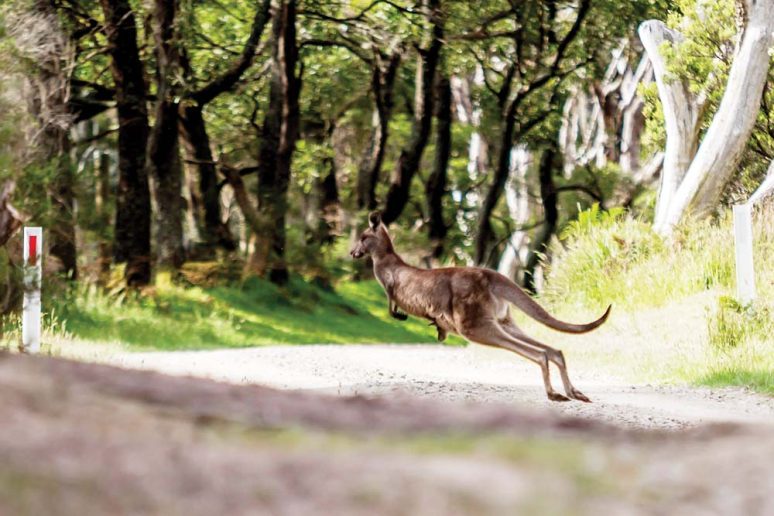THREE Mornington Peninsula “hot spots” for vehicle collisions with wildlife, especially eastern grey kangaroos, are being assessed for a trial of so-called “virtual fencing”.
Virtual fencing consists of devices mounted on posts being activated by approaching car headlights. The devices emit sounds and light which alert animals to approaching danger.
Animals near or about to cross roads are repelled by the sound and blue and yellow strobe-type LED lights causing them to run away as vehicles approach.
The devices placed at 25-metre intervals on both sides of the road run on solar powered batteries.
Greens Bush Association is coordinating the push for the alerts with the support of Southwest Mornington Peninsula Landcare Group, Mornington Peninsula Landcare Network and Mornington Peninsula Shire along roads on the southern peninsula.
The aim of the project is to protect wildlife and enhance the safety of drivers – many forced to pay hefty repair bills after collisions with kangaroos.
Three, two-kilometre long areas earmarked for the fencing are on Baldrys Road adjacent to and beyond Greens Bush, Mornington Peninsula National Park; Browns/Jetty roads adjacent to Peninsula Gardens Bushland Reserve, Jetty Road, east into Browns Road, and Purves Road south of Seamists Drive.
Virginia Carter, representing the Greens Bush Association, is working on the project with Mornington Peninsula Shire’s natural systems and roads and safety teams. She will be applying for funding when the Landcare grants come out at the end of this month as well as a Transport Accident Commission grant when COVID-19 restrictions ease.
“The funding I seek, if successful, will cover the costs of the fencing, with the council being asked to pay the costs of installation and maintenance.”
Ms Carter said wildlife was an “under-estimated challenge to traffic safety”.
“Every year many thousands of accidents involving wildlife and vehicles result in wildlife deaths and injuries, as well as injuries and loss of life to people, and damage to vehicles and property,” she said.
Wildlife Victoria acknowledges that the proposed trial areas have “high incident rates” while admitting its records probably underestimate the number of collisions as not all are reported.
Ms Carter said the CSIRO’s latest testing had shown a 50 per cent reduction in wildlife/vehicle collisions where virtual fencing has been installed.
Mornington Peninsula Landcare Network is backing the application for funding for virtual fencing in the Main Ridge area.
The networks’ president David Maddocks described it as a “vital addition to further ensure safe passage of wildlife throughout the biolink and overarching landscape”.
“Any funding or operational support obtained for the virtual fencing proposal of the Main Ridge area would greatly assist the Greens Bush to Arthurs Seat biolink project to achieve its intended outcome,” he said.
First published in the Southern Peninsula News – 26 May 2020




